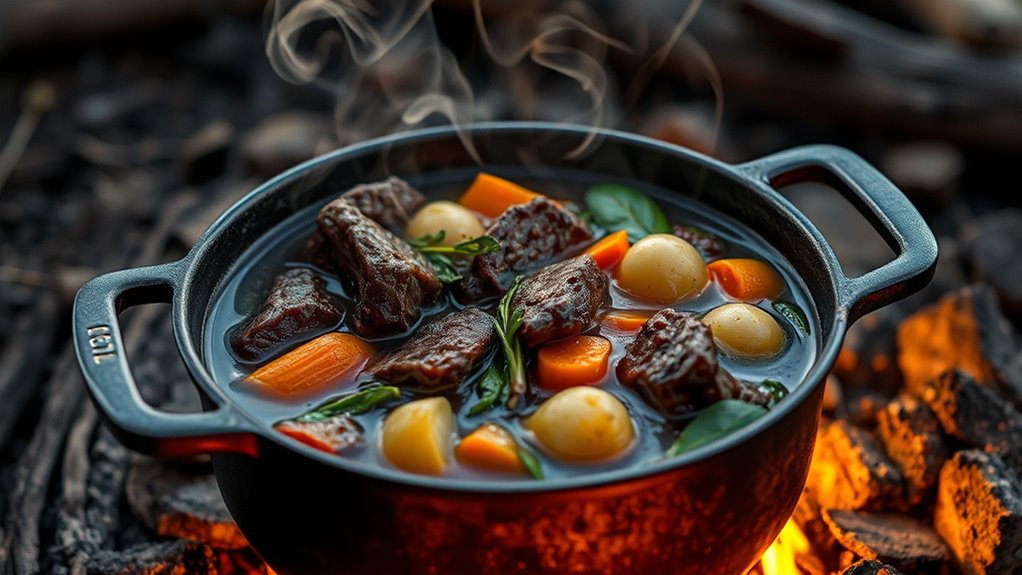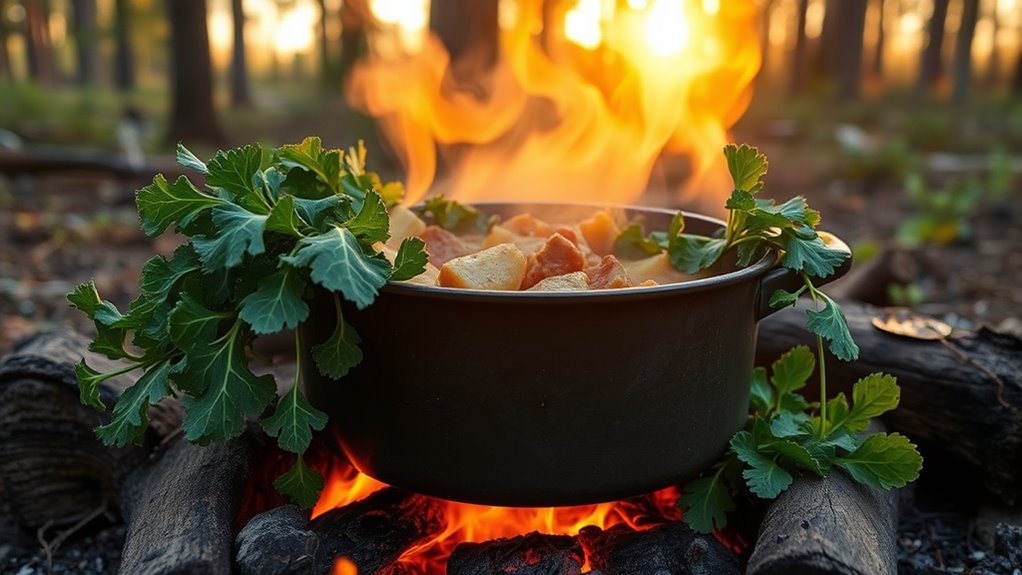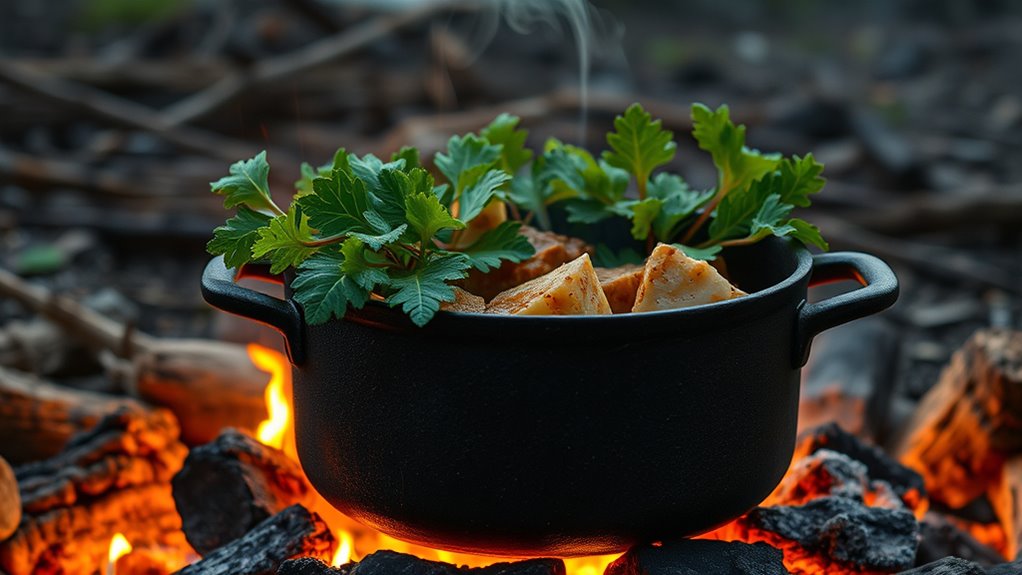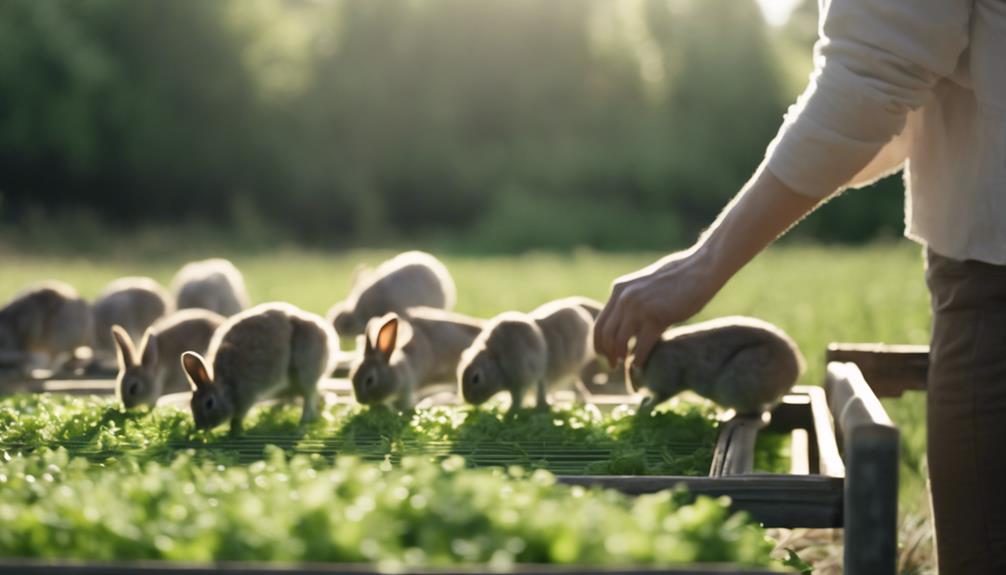To make a one-pot campfire stew with foraged greens, start by gathering fresh ingredients like meat, vegetables, and wild greens, preparing everything beforehand. Build a safe, manageable fire and maintain steady heat for slow-cooking the meat and vegetables until tender. Just before serving, add your foraged greens—like dandelion or chickweed—after washing thoroughly. With careful fire management and ingredient prep, you’ll create a flavorful, rustic meal. Keep going to discover all the tips for a perfect campfire stew.
Key Takeaways
- Gather fresh, seasonal ingredients including meat, vegetables, seasonings, broth, and edible foraged greens like dandelion or chickweed.
- Build a controlled campfire with dry tinder and kindling, maintaining consistent heat for slow cooking.
- Sear and simmer the meat and vegetables gradually, stirring occasionally, to achieve tender, flavorful stew.
- Forage and wash greens responsibly, then add them towards the end of cooking to preserve their nutrients and flavor.
- Serve the hot stew in sturdy, biodegradable containers, and enjoy responsibly with proper fire safety and cleanup.
Gathering Ingredients and Preparing Your Campfire

Before you start cooking, gather all the ingredients you’ll need for your campfire stew, such as hearty beef or vegetables, seasonings, and broth. Choosing quality ingredients sets the foundation for flavor enhancement, so pick fresh produce and well-seasoned meats. Think about ingredient substitution to adapt the recipe to what’s available—carrots for potatoes, or mushrooms instead of beef. This flexibility helps you make the most of foraged greens and pantry staples. Prepare everything in advance, chopping vegetables and measuring spices so you’re ready to cook over the fire. Having your ingredients organized ensures a smoother process and better flavor integration. Incorporating AI-powered recipe optimization can help suggest ingredient swaps based on what you have available, making your cooking experience more efficient. With your ingredients prepared, you’ll be ready to build a fire and start cooking your flavorful, one-pot campfire stew.
Building and Maintaining a Suitable Fire for Cooking

Building a proper fire is essential for cooking your campfire stew effectively. A well-built fire provides steady heat and flame control, ensuring your ingredients cook evenly. Always prioritize fire safety by choosing a safe, clear spot away from overhanging branches and tents. Maintain a manageable flame to prevent flare-ups or burning your food. Keep a bucket of water or dirt nearby to quickly extinguish the fire if needed. Regularly adjust and add wood as needed to sustain a consistent temperature. Use small, dry tinder and kindling to start, then gradually add larger logs. By controlling the flame and practicing fire safety, you’ll create an ideal cooking environment for your delicious stew. Proper fire management makes all the difference in outdoor cooking success, especially when leveraging architectural expertise to design optimal outdoor cooking setups.
Cooking the Meat and Vegetables to Tender Perfection

To achieve tender, flavorful meat and vegetables in your campfire stew, it’s important to cook them slowly over gentle heat. This slow simmer allows the flavors to meld and the ingredients to reach perfect tenderness. Consider seasoning variations like adding garlic, herbs, or a splash of vinegar to enhance depth. Stir occasionally to prevent sticking and ensure even cooking. As the meat and vegetables soften, taste and adjust the seasoning for balance. Once everything is tender, you can serve the stew alongside simple side dish ideas such as crusty bread, roasted potatoes, or cornbread. These complement the hearty flavors without overpowering them. Patience during this process guarantees your stew reaches that ideal balance of melt-in-your-mouth meat and perfectly cooked vegetables. Cooking techniques also play a vital role in ensuring even heat distribution and optimal tenderness throughout the dish.
Foraging and Adding Fresh Greens to the Stew

Adding fresh greens to your campfire stew enhances its flavor and nutrition, especially when foraged responsibly from nearby wilds or your garden. When foraging for wild edible plants, prioritize foraging safety by correctly identifying plants and avoiding polluted areas. Incorporate greens like wild spinach, dandelion greens, chickweed, or nettles for a hearty boost. Harvest only what you need, leaving enough behind for the plants to regenerate. Wash all greens thoroughly to remove dirt and insects before adding them to the stew. Be cautious of look-alikes that could be toxic, and stick to plants you’re absolutely sure about. Foraging wild edible plants is a rewarding way to add fresh, seasonal greens while connecting with nature safely. Proper identification is essential to ensure safety when foraging for wild edibles.
Serving and Enjoying Your Rustic Campfire Meal

Wondering how to best enjoy your campfire stew? First, confirm you observe cooking safety by using heat-resistant gloves and a stable cooking surface. Once the stew is ready, serve it in biodegradable bowls or sturdy cups, and use utensils you’ve brought along. Remember to follow campfire etiquette by keeping the fire manageable and extinguishing it properly after eating. As you gather around, take a moment to appreciate the flavors and the effort that went into foraging and cooking. Take small bites to savor the combination of greens and hearty ingredients. Share your meal with fellow campers, respecting their space and preferences. Enjoying your rustic campfire meal responsibly ensures everyone has a safe, memorable experience in the great outdoors. Also, be mindful of any spoiled ingredients that might have been used, and ensure your ingredients are fresh for the best flavor and safety.
Frequently Asked Questions
How Long Can Leftover Stew Be Safely Stored Overnight?
You can typically store leftover stew overnight safely if you follow food safety guidelines. Make sure to refrigerate it within two hours of cooking, using airtight containers to maintain freshness. Proper storage tips include keeping the temperature below 40°F (4°C) and reheating thoroughly before eating. Generally, leftover stew stays safe for up to 3-4 days in the fridge, but always check for signs of spoilage to guarantee safety.
Can I Substitute Different Meats or Greens in the Recipe?
Did you know that experimenting with new ingredients can boost your nutritional intake? When it comes to meat substitutions, you can swap chicken for beef, pork, or even plant-based options for variety. Greens alternatives like kale, spinach, or wild herbs work well too. Feel free to customize your stew based on what’s available or your taste preferences, making each batch unique and delicious!
What Are Common Mistakes to Avoid When Building a Campfire?
When building a campfire, you want to focus on fire safety and proper fire building techniques. Avoid mistakes like building a fire on windy days or too close to tents and trees. Don’t use accelerants or leave the fire unattended. Make sure to start with tinder, then add kindling, and finally logs. Always keep water or a fire extinguisher nearby, and fully extinguish your fire before leaving to prevent wildfires.
How Do I Adjust Cooking Time for Different Fire Intensities?
Think of your fire as a musical instrument—adjusting fire temperature changes the tune. If the flames are high, your cooking duration shortens, so check your food often to prevent burning. For lower heat, extend the cooking time gently. I once cooked stew over a flickering fire, noticing it took twice as long. Always monitor your fire and adapt your cooking duration accordingly to achieve perfect results.
Are There Vegetarian or Vegan Variations of This Stew?
You can easily make this stew vegetarian or vegan by swapping out meat with plant-based alternatives like tofu, tempeh, or hearty vegetables. Use vegan seasoning to enhance flavor without animal products. Incorporate foraged greens for added nutrition and freshness. Just remember, cooking times might vary depending on your ingredients, so keep an eye on the stew and adjust as needed for a rich, satisfying plant-based meal.
Conclusion
Once your stew’s bubbling and the greens are tender, you’ll feel like a true outdoor chef, crafting a hearty meal in the wild. Savor the rich flavors and the satisfaction of cooking over an open flame, just like ancient explorers. With each spoonful, you’re not just feeding your body, but also embracing nature’s simplicity. So, gather your friends, share stories around the fire, and enjoy this rustic, one-pot feast under the open sky.










